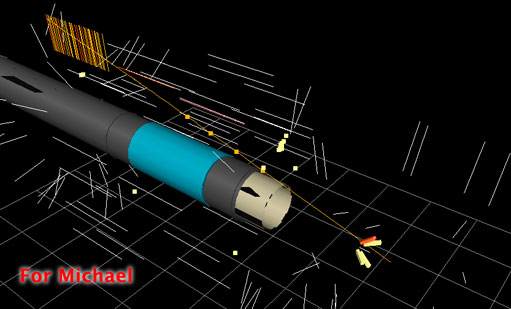
ATLAS e-News
23 February 2011
Michael Niegl (1985-2009)
9 February 2009

One of the first cosmic tracks seen by the Beam Conditions Monitor, shown here going through the TRT Endcap C, the SCT Barrel (3 layers), the SCT Endcap A (1 layer), and finally through the BCM module A side +y.
It is with great regret that we announce the passing of Michael Niegl. Michael was a Master's student in Microsystems Engineering at the University of Applied Sciences Wiener Neustadt, and spent several months at CERN. He was responsible for the development of the ATLAS Beam Conditions Monitor (BCM) firmware, which acquires the data from the BCM detector modules and provides online monitoring of the LHC beams within the ATLAS experiment.
Tragically, Michael died in a car accident in the early hours of 2009.
After receiving First Class Honours for his Bachelor’s degree, Michael spent six months at CERN in 2008 to finish the development and commissioning of the ROD firmware for the first beam. He worked the entire night on September 10th, fine-tuning the system for the first beam. “It was a joy to be with him, seeing the first beams in the ATLAS control room,” his friends and colleagues remember.
Michael was due to return to CERN on January 5th to start a six-month stint as a Technical Student, commissioning the BCM RODs for the next beams and writing his Master’s thesis.
“First and foremost, Michael was a great friend,” say his friends, adding: “[He] was sweet, honest, and able to make everybody feel at ease.” Michael was known for his extremely positive outlook on life; he was able to find the good in every situation. Although he will be remembered for his ability to crack jokes and bring a smile to everyone’s faces, they are sure, “He will forgive us if, instead, we are [now] all very sad.”
“His joyful yet hard-working attitude will always remain in our memories,” assure his friends, speaking in the CERN Bulletin. “He will be missed. Our thoughts and condolences during these sad days go to his parents, his family, and his many friends and colleagues.”

By Ceri Perkins, written with the help of Michael's friends and colleagues at CERN
|